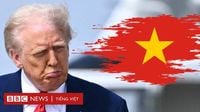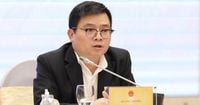On April 6, 2025, Deputy Minister of Industry and Trade, Truong Thanh Hoai, articulated the potential repercussions of the recently announced 46% reciprocal tariff imposed by the United States on Vietnamese goods. During a press conference, he expressed concerns that this steep tax, set to take effect on April 9, could significantly hinder Vietnam's export activities, economic growth, foreign direct investment (FDI) attraction, and overall labor market.
Hoai emphasized that the imposition of such tariffs would escalate the prices of Vietnamese exports in the US market, thereby diminishing their competitiveness against products from other nations. He stated, "When taxes increase, the price of Vietnamese goods in the US will increase, reducing competitiveness with goods from other countries. Secondly, the purchasing power of US consumers will also decrease, so Vietnamese goods will decrease." This dual impact could lead to a decline in demand for Vietnamese products, particularly in major export sectors such as electronics, textiles, and footwear.
He also raised alarms about existing contracts, indicating that US businesses might reconsider their purchasing commitments. "For signed contracts, US businesses will consider whether to continue buying goods. New contracts will be even more difficult," he warned. This uncertainty looms large over the trade relationship, raising questions about the future viability of many Vietnamese exports.
At the same press conference, Minister Tran Van Son highlighted Vietnam's proactive measures to mitigate the effects of the new tariff. He noted that the Vietnamese government had already begun implementing strategies to reduce tariffs, increase imports, and address the legitimate concerns of US businesses. "Vietnam has proactively implemented many solutions to reduce taxes, import goods, and resolve legitimate requests from US businesses," he stated.
Prime Minister Pham Minh Chinh, who chaired a government meeting on April 5, reinforced the commitment to maintaining Vietnam's GDP growth target of 8% for 2025, despite the challenges posed by the new tariff policy. He acknowledged that while the US is Vietnam's largest export market, it is not the only one, pointing to potential opportunities in regions such as the Middle East, Central Asia, and South America. "We need to restructure our export markets and enhance the quality of our products," he remarked.
The reciprocal tax policy, announced by President Donald Trump on April 2, can be viewed as an additional layer of taxation on top of existing tariffs and fees that the US applies to imported goods. Although not all Vietnamese goods will be subjected to this new tax, the 46% rate poses a substantial threat to various sectors of the Vietnamese economy.
In light of these developments, Vietnamese officials are actively seeking to delay the implementation of the tax and negotiate for a reduction. Both the Vietnam Chamber of Commerce and Industry (VCCI) and the American Chamber of Commerce in Hanoi (AmCham) have expressed their apprehensions regarding the impending tax in a letter addressed to US Secretary of Commerce Howard Lutnick. They described the 46% tariff as "incredibly high" and detrimental to the bilateral trade relationship, urging the Trump administration to reconsider its stance.
"Lowering taxes on products imported into Vietnam and those reaching US consumers is beneficial for US companies, the economy, and consumers," the letter stated. It further emphasized that increasing taxes would not yield the desired benefits for either side.
Meanwhile, Deputy Minister of Finance Do Thanh Trung acknowledged the psychological impact of the tariff on investors and the business environment. He noted that the government had responded swiftly to the situation, suggesting that the reactions observed in the stock market, where the HoSE index dropped over 100 points within two days, might have been exaggerated. "The government’s efforts will certainly restore investor confidence," he asserted.
The discussions between Vietnam and the US have been characterized by a desire to enhance bilateral cooperation. Hoai mentioned a recent successful phone conversation between General Secretary To Lam and President Trump, during which both leaders expressed a willingness to explore avenues for tariff elimination. "The two leaders agreed on a plan to eliminate tariffs, demonstrating a mutual interest in strengthening ties," he said.
In this context, Vietnam is not only looking to manage the immediate impacts of the tariff but also to leverage this situation as an opportunity to restructure its economy towards a more sustainable and technology-driven model. Prime Minister Chinh emphasized the importance of resilience and adaptability in facing external shocks, urging the government to implement innovative solutions to support businesses and stimulate domestic consumption.
As the April 9 deadline for the tariff approaches, the Vietnamese government remains engaged in negotiations with US officials, advocating for a temporary postponement of the tax while discussions continue. This proactive approach reflects Vietnam's commitment to maintaining its economic stability and fostering a favorable business environment amidst global trade challenges.
The unfolding situation highlights the complexities of international trade relations and the delicate balance that countries must maintain to protect their economic interests while navigating the pressures of global market dynamics. As both nations work towards a resolution, the outcome will undoubtedly shape the future of US-Vietnam trade relations and the broader economic landscape in the region.





